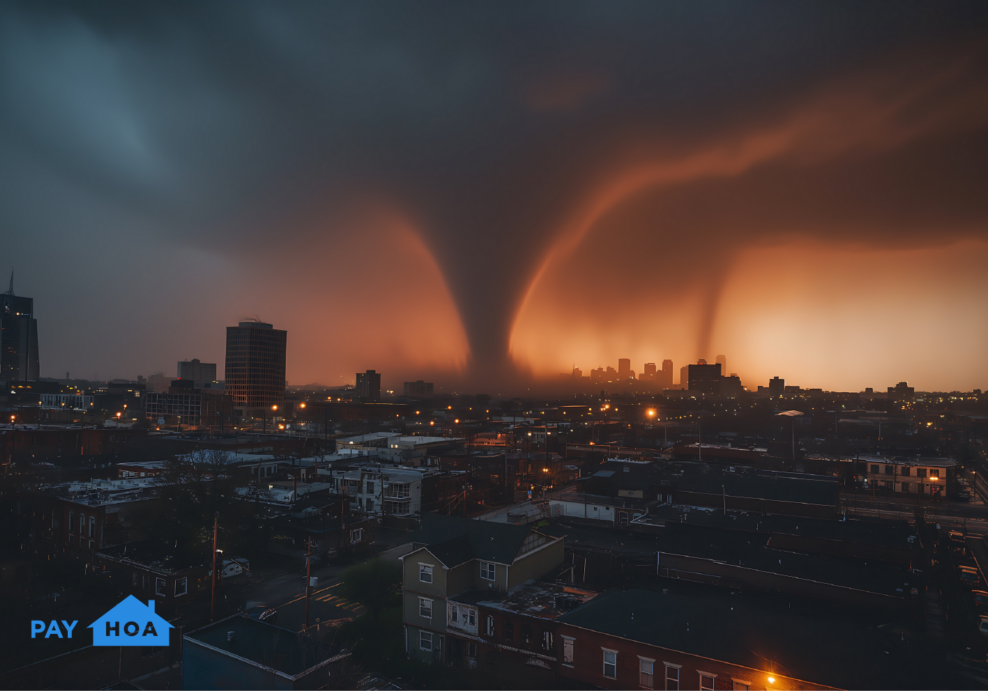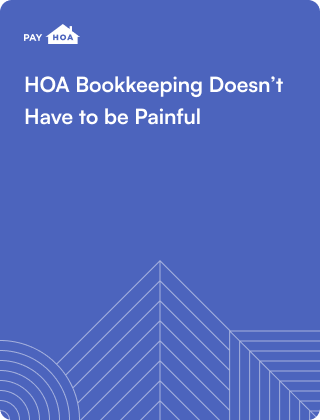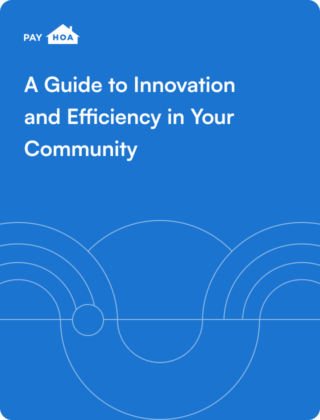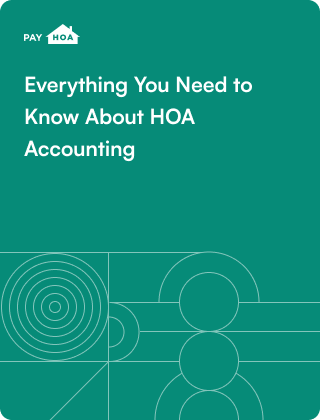 Jesse Hitt • 24 Jun 2024 • 7 min read
Jesse Hitt • 24 Jun 2024 • 7 min readHOA Software: Part of Your Disaster Response Plan

Fans recently flocked to movie theaters across the country to weather the storms of Twisters, watching the scary effects of climate change play out on the big screen. While it’s a thrill to view these forces of nature from a safe distance and with the comfortable barrier of a fourth wall, natural disasters are becoming increasingly common IRL. In fact, the number of extreme weather events has increased five-fold over the past 50 years. “Thanks, Captain Sunshine,” you might be thinking. “What does this have to do with my self managed HOA?” We’re glad you asked.

What Exactly *Is* a Disaster?
Epic fails fill our feeds on the daily, but we’re not talking about that kind of disaster. Real disasters follow real patterns with real consequences.
- Disasters typically occur with little to no warning.
- They result in extensive damage and disruption.
- Disasters lead to loss of life and significant economic costs.
- They necessitate immediate response from emergency services and disaster management agencies.
There are two types of disasters — natural and human made. Natural disasters include earthquakes, avalanches, and droughts, to pandemics, infestations, and extreme temperatures. There’s no control since they occur due to natural processes of the Earth. Human-made disasters can be unintentional, like industrial accidents and chemical spills, or intentional, like acts of terrorism and deforestation. In 2023, there were 398 natural disasters worldwide, causing 86,473 fatalities and affecting over 93.1 million people globally.

If You Think It Can’t Happen to You, Think Again
It’s impossible to predict when and where natural disasters will occur. But the fact that they’re happening more frequently should be a concern for everyone.
Maui Wildfire
The Maui wildfire in August 2023 devastated the island, burning approximately 2,000 acres and destroying over 500 homes and structures. The fire, fueled by strong winds and dry conditions, led to significant ecological damage and displaced numerous residents, emphasizing the growing wildfire risks in Hawaii
Texas Winter Storm
A severe winter storm hit Texas and other parts of the southern United States in 2021, causing widespread power outages, water supply issues, and significant economic losses. The storm led to at least 210 deaths and highlighted vulnerabilities in infrastructure during extreme weather events.
Hurricane Ida
In 2021, Hurricane Ida made landfall in Louisiana as a Category 4 storm, causing extensive damage from high winds and flooding. The hurricane led to widespread power outages, significant property damage, and at least 91 deaths across multiple states as it moved inland
Midwestern Derecho
A powerful derecho swept across the Midwest, causing widespread damage in Iowa, Illinois, and Indiana in 2020. With wind speeds comparable to a Category 4 hurricane, the storm caused significant agricultural losses, property damage, and power outages, resulting in four deaths and over $11 billion in damages.
Central U.S. Tornado Outbreak
A destructive tornado outbreak in March 2023 produced over 150 tornadoes across several southern and central states. This was the largest outbreak in a 24-hour period for the month of March, causing 33 deaths and $5.7 billion in damages.
Though these catastrophic events impacted a wide variety of locales — from rural to urban and everything in between — it’s very likely that many of these areas featured communities reliant on self managed HOA groups like yours. There’s no way of knowing how prepared they were, but you can help ensure your neighborhood’s safety is at the top of your mind. Things aren’t all doom and gloom, but disaster could strike your community. The question is, if it does, is your self managed HOA prepared?
While disaster response is a job for police, firefighters, and paramedics or local emergency management officials and FEMA, homeowners association software can play a helpful part in the moment, too. When the police need to communicate with your entire neighborhood at once or when you need to distribute real-time accurate information, do you really want to do that on a public Facebook feed or NextDoor?

But First, a Disaster Response Plan (Then, Coffee)
Young homeowners, now forming the largest share of the market, are particularly concerned about climate disasters — as they should be. Because you’re likely to have a variety of generations in your community, addressing all concerns can significantly ease minds and foster a sense of security among everyone. A basic disaster response plan might include the following:
- Conduct a risk assessment.
- Assign roles and responsibilities.
- Develop emergency procedures.
- Assemble and maintain emergency supplies.
- Conduct training and drills.
A disaster response plan should be flexible and adaptive. Rigid plans can fail under pressure. Instead, prepare to adapt as you go, ensuring all possible resources are in place and be ready to modify your actions based on real-time developments. You can better support your plan with homeowners association software like PayHOA, which has built-in tools to make communication, finances, and management run smoothly.
Upload and share comprehensive disaster response plans, evacuation routes, and emergency contact lists in one central place. The platform can also securely store digital copies of important documents, such as insurance policies or property deeds. Because it’s cloud-based, PayHOA provides redundancy and ensures documents are not lost even if local systems are compromised.
Close Your Eyes and Picture This
Imagine it’s a calm afternoon in your community when suddenly, weather alerts indicate a severe tornado warning. The skies darken, and within minutes, a powerful tornado touches down, causing significant damage to homes and infrastructure. What do you do? What do you do?? This is where homeowners association software comes in.
Send out real-time notifications to all residents through instant mass communication tools. As soon as the tornado warning is issued, the HOA board uses PayHOA to immediately alert all residents, informing them of the impending danger and providing instructions to seek shelter. After the tornado passes, the board can send updates regarding safe zones, emergency services contact information, and areas to avoid due to damage.
PayHOA’s private message boards are used for secure, two-way communication between residents and the HOA board. Here, residents can report damage, share their status, and ask for assistance in one centralized platform, which reduces misinformation and ensures everyone is informed. The board can also create specific threads for volunteers, requests for aid, and updates from emergency services, streamlining the organization of community support efforts.
Deploy quick surveys and polls immediately after the tornado. Responses can help assess residents’ needs, such as medical attention, temporary housing, or other urgent assistance.
Use automated tools to help your HOA navigate the financial challenges that often accompany disasters. Efficiently tracking expenses, managing budgets, and ensuring transparency can significantly ease recovery.
Homeowners Association Software Works When Things Are Fine, Too
Hopefully, you never find yourself fighting against the elements and you just use homeowners association software to accomplish the boring tasks that fall to volunteers within a self managed HOA.
- Send automated invoicing for dues, fees, fines, and late fees.
- Access real-time, accurate accounting.
- Handle maintenance, general, and architectural requests.
- Send messages on demand or schedule for the future.
- Provide residents with multiple options for online payment.
- Customize your chart of accounts or use a free template.
PayHOA’s comprehensive platform provides the tools to communicate effectively, gather crucial data, and manage your finances, empowering you to lead your community through the good times and the bad.
PayHOA offers a homeowners association software solution for HOAs of any size or managerial priorities. To find out if PayHOA fits all your HOA management needs, try our software free for 30 days.
Share this article:
Enjoyed this Article? Try Another!
HOA Bookkeeping Doesn’t Have to be Painful
If you’re a leader or volunteer in a homeowners association, you probably got involved because…
A Guide to Innovation and Efficiency in Your Community
Introduction Running a homeowners’ association (HOA) presents unique challenges — whether it’s managing budgets, coordinating…
Everything You Need to Know About HOA Accounting: Easily Achieve Best Practices with HOA-Specific Software
Volunteering for your HOA is more than going to meetings, approving requests, enforcing violations, and…


